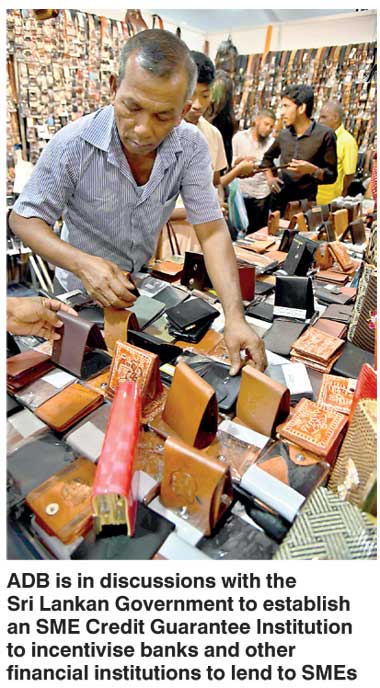Friday Dec 13, 2024
Friday Dec 13, 2024
Tuesday, 22 November 2016 00:02 - - {{hitsCtrl.values.hits}}
https://blogs.adb.org: The public sector is a key driver of private sector development across Asia’s developing member countries  simply because from a development perspective it makes good economic sense. Sri Lanka is an excellent example of how this works at its best.
simply because from a development perspective it makes good economic sense. Sri Lanka is an excellent example of how this works at its best.
The Sri Lankan Government has been proactive about strengthening the financial sector, and over the past year, ADB has approved two important operations, namely a Small and Medium-Sized Enterprises (SMEs) Line of Credit Project in January and a Capital Markets Development Program in October. Both public sector operations have as goals mobilising finance for the private sector. A third operation in the 2017 pipeline is to establish an SME Credit Guarantee Institution to further catalyse lending to SMEs.
Despite Sri Lanka having in place the foundations for SME lending—including a Secured Transactions Act, registries for both immovable and movable property, and other important infrastructure such as an automated credit information bureau—SMEs continue to raise access to finance as one of their main constraints. Indeed, the demand for SME credit is enormous, with only a fourth of firms having sufficient access to credit, the lowest out of 29 Asian countries in a recent survey. In response, ADB has provided a credit line to Sri Lankan banks to support SME lending.
Such credit lines, however, are sometimes criticised for crowding out other lenders. This project put this criticism to the test by introducing a simple allocation mechanism to assess demand for ADB’s credit, namely an auction. Banks periodically bid for loanable funds based on a highest price (or interest rate) auction. The highest bidding banks then have three months to build their  loan books. The auction beats the business-as-usual allocation system in two ways.
loan books. The auction beats the business-as-usual allocation system in two ways.
First, it establishes the market rate for the funds through harnessing the forces of demand and supply. This prevents crowding out. Second, through well-defined rules, banks have to fully use their allocated funds before they can participate in future auctions (the carrot) and pay a financial penalty if they don’t (the stick), thus placing a premium on efficiency through timely use of the funds. In essence, public sector resources support credit for SMEs through a competitive and transparent market process.
While we are still at an early stage having completed two of the proposed eight auctions, the results are encouraging. We have had a nice distribution of spreads among the bids placed by participating banks—at times coming in at higher prices than anticipated—and equally important the loan books have been efficiently built and over 80% of the funds have been lent to SMEs outside of Colombo, women-led SMEs, or SMEs that had never previously borrowed from a commercial bank. While the jury is still out, this auction process may serve as an innovative instrument to establish a market for wholesale funding and make public sector support for private sector development more potent.
Turning to our Capital Markets Development Program, it seeks to mobilise larger flows of investment. Against a range of standard indicators—be it stock market capitalisation, mutual fund or insurance penetration—Sri Lanka is significantly behind peer comparators given income per capita and other benchmarks. The program was designed with an acute awareness of the importance of relaxing constraints on demand, supply and overall market facilitation.
On the demand side, the hallmarks of the program are to demutualise the Colombo Stock Exchange to ensure that governance practices are fully aligned with market development and to enforce listing requirements to provide assurances to investors. On the supply side, the program calls, among others, for the Government to list shares of at least three State-Owned Enterprises on the stock market.
Finally, market facilitation includes adoption of enabling legislation such as the new Securities and Exchange Commission Act and amendments to the Sri Lanka Accounting and Auditing Standards Act to facilitate private investment. Importantly, the program also supports developing deeper and broader bond markets including building a reliable yield curve. This entails simplifying the government securities market’s auction rules and providing ex-ante information through the publication of an auction calendar.
Supporting the private sector isn’t just about making more funds available. Banks can have deep funding but still will not lend if they’re not reasonably certain of being repaid. For protection, banks often require borrowers to provide collateral. Yet, many SMEs don’t have collateral to provide. An ADB-funded survey of 132 Sri Lankan SMEs identified the lack of title or other collateral as the most common barrier to accessing finance. These SMEs face the frustrating choice of foregoing growth or turning to informal financing, which tends to be short term and at higher interest rates imposing higher costs and refinancing risk to SMEs. More to the point, it is at best expensive and at worst illegal.
ADB is in discussions with the Sri Lankan Government to establish an SME Credit Guarantee Institution to incentivise banks and other financial institutions to lend to SMEs. Similar facilities exist across North America, Europe, and Asia. We learn from their experiences that public sector support building upon private sector expertise is key.
On the one hand, guaranteeing SME loans—particularly to borrowers with no collateral—isn’t sufficiently profitable to attract pure private investment. On the other hand, the public sector needs to rely on banks and other financial institutions’ market knowledge and delivery systems to channel the support effectively. It’s a classic case of public sector support enabling private sector growth.
Not all countries are positioned to replicate what Sri Lanka has achieved. It takes a mix of enabling policy, public sector risk sharing, and private sector business acumen. Yet, where these conditions exist, national governments working with ADB and other development partners can support the private sector so that it can, in turn, promote development.